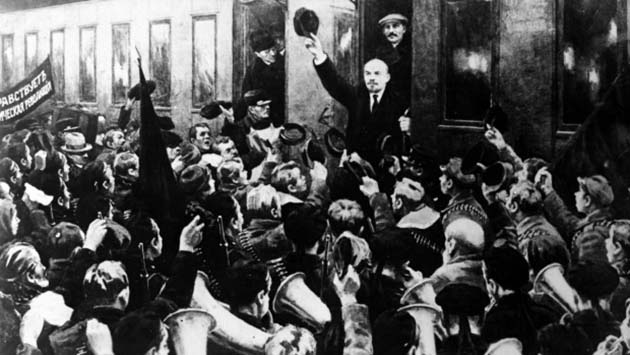Lenin’s view on the need for a revolutionary party was a product of the experience of the greatest wave of struggles against capitalism so far in history, writes James Supple
Lenin was the key leader of the October revolution in Russia in 1917. This was the first and so far the only time that capitalism has been overthrown in a major country.
And in the 1920s he helped lead the Third International, grouping together newly-formed Communist parties around the world. This movement represented the most serious challenge to capitalism on a global scale so far in history.
Lenin’s most important legacy are his ideas and experience on the question of organisation. For this the Marxist philosopher Georg Lukacs described him as the greater thinker in the revolutionary socialist tradition since Marx.
Without the Bolshevik Party, which he helped build, the revolution in Russia would never have succeeded.
Before Lenin the accepted view on the left was that a broad party was needed that included both reformists and revolutionaries, aiming to unite essentially the whole working class.
This was expressed in the construction of mass socialist parties in major European countries like Germany and France.
But this model was shattered by the outbreak of the First World War. Almost without exception the broad socialist parties capitulated and supported the war effort in their respective nations.
This exposed that they had become thoroughly reformist, committed above all else to winning influence and eventually government through parliament.
Only the Bolshevik party that Lenin had built in Russia was willing to oppose the war, and capable of leading a revolutionary movement to bring it to an end.
Lenin’s party was based on clear revolutionary socialist politics. This meant socialists forming a party of their own separate from the reformist parties that aim to take power through parliament.
His organisation, the Bolshevik Party, was built as a party of the minority in the working class committed to revolutionary socialism. It was built around a commitment to change from below through mass struggle, and arguing to win support for socialist politics inside the working class.
A broader organisation is forced to come up with compromise positions tailored to bridge fundamental differences of principle over how to change society.
This means a distinct revolutionary socialist organisation can be more effective within social movements and the trade unions because its arguments and activity can be sharper and clearer.
Different models
Lenin’s argument on the need for a separate party of revolutionaries remains controversial.
Across Europe and the US, new left-wing parties and leaders have emerged in recent years to challenge the political mainstream. They range from figures within established parties like Jeremy Corbyn in the British Labour Party and Bernie Sanders within the US Democratic Party, to new parties like Podemos in Spain, Jean-Luc Mélenchon’s party in France and Syriza in Greece.
What they have in common is the effort to build a broad party of the left, similar to the accepted model of the party before Lenin.
The Greens in Australia work in a similar way. Particularly in NSW, the party combines people who describe themselves as socialists and anarchists, activists who are mainly concerned about the environment and others who simply want a more left-wing alternative to the Labor Party.
It is often argued that parties like this can combine social movement activism with running successful election campaigns.
But in practice they all prioritise electoral work and the effort to change society through parliament.
Their time, money, resources and efforts to mobilise their members are all focused around elections.
But the aim of forming a left-wing government through parliament always ends in disappointment. With it comes a pull towards accommodation with the mainstream parties and the political elite to cut deals and “deliver outcomes”.
We saw this when The Greens went into an Alliance with the Gillard Labor government from 2010, and in current leader Richard Di Natale’s willingness to consider supporting the Coalition’s Gonski 2.0 school funding plan.
This is because forming government through the existing parliamentary system means agreeing to manage capitalism. The ultimate recent demonstration of how a parliamentary strategy fails is the experience of Syriza in Greece. It went from promising a left government in 2015 that would tear up the austerity deal with the European Union to implementing even more savage austerity cuts once in power, within an astoundingly short period.
Faced with the terrible experience of parliamentary parties—both the mainstream and more radical examples—others argue against forming a political party altogether.
One extreme example is the 15M movement in Spain that emerged as a response to the economic crisis in 2011. It banned participation by political parties completely, with the flags and publications of even revolutionary socialist organisations kept out of its events.
The problem with this is that any real social movement contains people with a mix of political ideas and views. This means there will be political debates about what to do and how to respond to new challenges.
The 15M movement itself is a telling example. Although it tried to exclude politics and political parties, the movement around it was eventually channelled into forming Podemos, a party that aimed to form government through running in elections.
Broad movements
Social movements and trade unions both draw their strength from uniting broad layers of people.
Most social movements are coalitions, ranging from supporters of different left-wing parties to religious groups. Trade unions need to involve as large a section of the workplace as possible in order to stage effective strike action.
The radical sections of the movement need to organise within them to be best placed to win debates over the way forward. This is why a separate revolutionary socialist organisation is needed.
The refugee movement for instance encompasses a wide range of groups from professional activist organisations like Getup and the Refugee Council, to grassroots activist groups like Mums for Refugees, Grandmothers against Detention and the Refugee Action Collectives.
Some of these groups put significant effort into lobbying, in the hope that putting information in front of MPs and appealing to their consciences can produce change.
Sometimes refugee supporters also argue that individual cases can be dealt with through the court system or private approaches to politicians.
Socialists within the campaign argue for mass mobilisations to build political pressure on the government for change. Key to this is building support within the unions, with the aim of mobilising the power of workers through industrial action.
We insist that there are political interests at stake, based in the efforts of the ruling class to defend their wealth and power.
The different approaches within social movements reflect the division between reform and revolution—whether to work through the “right channels” and rely on the institutions of society to bring change or whether to try to mobilise mass pressure against them.
Mixed ideas
The need for a separate socialist organisation also flows from an understanding that the dominant ideas in society are the ideas of ruling class. In our society a tiny minority of people, the top 1 per cent of billionaires, CEOs and shareholders, control enormous wealth and power. This class controls most of the mainstream media. It also has its own political parties, think tanks, and friendly academics, who pump out ideas to justify the way society is run.
The result is that the working class majority is mixed and uneven in terms of its ideas.
Some people accept practically all of the right-wing and pro-capitalist ideas: from sexism to racist nonsense that refugees and immigration are a threat to jobs or “our way of life”, or the idea that inequality reflects natural talent and hard work.
This is reflected in the fact that a section of the working class votes for the Liberals.
But within the working class there are also dedicated trade unionists, willing to stand up to management to defend their workmates, and people who reject sexism, racism and homophobia.
The aim of a revolutionary socialist organisation is to group together the most left-wing workers, students and activists, those committed to a vision of a socialist alternative, so we can be most effective in winning support for anti-capitalist ideas.
It must be a party of leaders, whose activists are capable of winning arguments within their own workplace, unions or community struggles.
Such an organisation provides a space for revolutionary activists to share experiences, debate how to operate and map out a strategy to take the wider movement forward.
The importance of a revolutionary socialist organisation becomes even clearer during periods of mass social upheaval. Lenin’s party was able to argue and shape the direction of the revolution in Russia because it had tens of thousands of members capable of giving a lead to workers across Russia.
At key points it was the decisive intervention of the party that was able to both unite the working class movement against the threat of a military coup, as well as prevent an attempt at a disastrous premature seizure of power in July 1917.
The lack of such a party has seen countless waves of struggle, and numerous revolutionary opportunities, end in defeat.
The most recent example is the fate of the Egyptian revolution. This saw Hosni Mubarak’s dictatorship overthrown through mass protests in 2011. But in 2013 another wave of protests erupted against the Muslim Brotherhood government in the face of anger over its failure to improve living standards, a surge in fuel prices and the repression of strikes.
The lack of a mass revolutionary socialist party allowed the military to take the political initiative, and divert popular anger into support for reinstalling military rule.
Lenin’s ideas on party organisation remain a vital guide both to building the more modest struggles of today, and preparing for the upheavals capitalism is certain to produce in the future.






